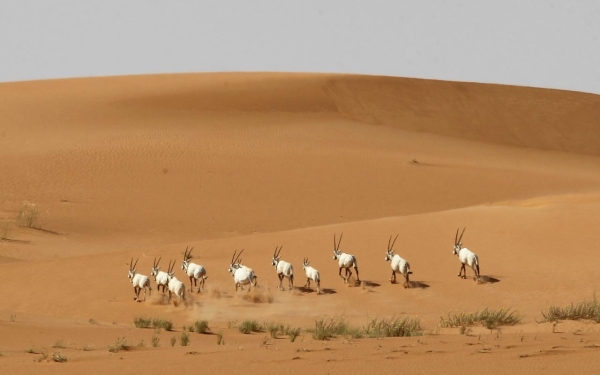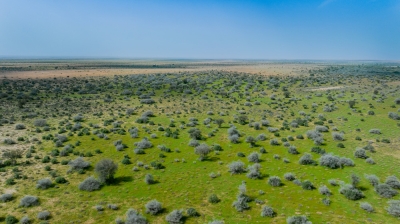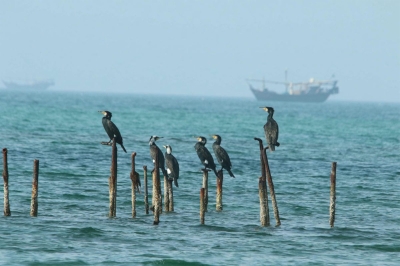
Uruq Bani Ma'arid Reserve is one of the natural reserves in the Kingdom of Saudi Arabia. It is located on the southwestern edge of Al-Rub' Al-Khali (Empty Quarter) Desert north of Najran Province. It includes a number of land formations and important natural wildlife habitats, including high sand dunes and a towering limestone plateau. It is considered the first model national reserve in Saudi Arabia.
Establishment of Uruq Bani Ma'arid Reserve
Uruq Bani Ma'arid Reserve was founded by a Royal Decree in 1992 for the purpose of protecting the natural landscape of Al-Rub' Al-Khali Desert and serving as a habitat for the reintroduction of the main species of wildlife in the Arabian Peninsula, including: Arabian oryx (Oryx leucoryx), Arabian sand gazelle or reem (Gazella marica), and Mountain Gazelle (Gazella gazella cora). The Uruq Bani Ma'arid Reserve is supervised by the National Center of Wildlife (NCW) with an area of approximately 12,787 km. Protection is divided into two levels at the reserve: one for wildlife, and another for the environment and flora species.
Features of Uruq Bani Ma'arid Reserve
The Uruq Bani Ma'arid Reserve is the first model reserve in Saudi Arabia to adopt modern techniques, such as using drones for monitoring and surveillance, and conducting environmental surveys and studies; using renewable energy and adhering to environmental sanitation controls; developing the ecotourism program; engaging the local community; and adopting an advanced management plan for running the reserve.
Wildlife at Uruq Bani Ma'arid Reserve
The reserve is home to a variety of native plant and animal communities. Its environmental condition is generally classified as good, and its plant and animal wildlife species are representative of arid environments. The most important animals are: the Arabian wolf (Canis lupus arabs), sand cat (Felis margarita), Rüppell's fox (Vulpes rueppellii), striped hyena (Hyaena hyaena), Hyrax (Hyracoidea), and cape hare (Lepus capensis). The main bird species at the reserve are: houbara (MacQueen's) bustard (Chlamydotis macqueenii), Pterocles (Pterocles coronatus), Arabian partridge (Alectoris melanocephala), Great grey shrike (Lanius excubitor), Egyptian vulture (Neophron percnopterus), and several lark species, as well as several types of reptiles and monitor lizards. Some of its common plant species are saxaul (Haloxylon ammodendron), Feathertop (Pennisetum villosum), acacia, moringa, wild rue (Peganum harmala), tamarix, and calotrope (Calotropis procera).
The reserve was the last known habitat in the Arabian Peninsula where the Arabian oryx was spotted in 1979, and the Arabian ostrich (Struthio camelus syriacus), Arabian sand gazelle or reem, Dorcas gazella (Gazella Dorcas), and the Nubian ibex (Capra nubiana) used to inhabit the reserve in the past. In 1995 and 1996, the program for the resettlement of oryx and sand gazelle was successfully implemented at the sanctuary. Since then, these animals have adapted and naturally reproduced in a protected environment, and their numbers are currently steadily increasing.
Desert tourism at Uruq Bani Ma'arid Reserve
In 2018, Saudi Arabia's first desert tourism project was launched at the reserve. The project includes desert hotel services offered through country houses spread over an area of more than six thousand m, as well as the revival of sporting and recreational activities, such as sand skiing, mountain climbing, and safari trips throughout the reserve. In 2022, forty scimitar oryx (Oryx dammah) and ten Arabian gazelles (Gazella arabica) were released at Uruq Bani Ma'arid Reserve, as part of the NCW program to propagate and resettle endangered species in natural habitats across all provinces of Saudi Arabia.
Adding Uruq Bani Ma'arid Reserve on the World Heritage List
On September 20, 2023, it was announced that Uruq Bani Ma'arid Reserve had been inscribed on the UNESCO World Heritage List as Saudi Arabia’s first natural World Heritage site. It joins other registered Saudi sites, namely: Hegra, Al-Turaif District, Historic Jeddah, Rock Art Hail Province, Al-Ahsa Oasis, Hima Cultural Area, and the Cultural Landscape of Al-Faw Archaeological Site.
Related quizzes
Related articles


